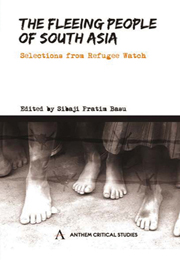Book contents
- Frontmatter
- Contents
- Acronyms and Abbreviations
- Foreword by Ranabir Samaddar
- Preface
- ETHICAL ISSUES
- LAWS
- SOUTH ASIA
- INDIA
- Introduction
- Population Displacement in India: A Critical Overview
- Reporting from Gagan Geer: A Kargil War Refugee Camp
- Barricaded Kashmiri Pandits Letting Go the Right to Return?
- Homeless and Divided in Jammu and Kashmir
- Internal Displacement in North-East India: Challenges Ahead
- The North-East Today: Displacing Identities, Displaced Identities
- Tibetan Refugees in India: Surviving in Exile
- Unrest and Displacement: Rajbanshis in North Bengal
- Adivasis in Coal Mining
- GENDER
- INTERVIEW/CORRESPONDENCE
- REPRESENTATIONS
- Index
Tibetan Refugees in India: Surviving in Exile
from INDIA
Published online by Cambridge University Press: 05 March 2012
- Frontmatter
- Contents
- Acronyms and Abbreviations
- Foreword by Ranabir Samaddar
- Preface
- ETHICAL ISSUES
- LAWS
- SOUTH ASIA
- INDIA
- Introduction
- Population Displacement in India: A Critical Overview
- Reporting from Gagan Geer: A Kargil War Refugee Camp
- Barricaded Kashmiri Pandits Letting Go the Right to Return?
- Homeless and Divided in Jammu and Kashmir
- Internal Displacement in North-East India: Challenges Ahead
- The North-East Today: Displacing Identities, Displaced Identities
- Tibetan Refugees in India: Surviving in Exile
- Unrest and Displacement: Rajbanshis in North Bengal
- Adivasis in Coal Mining
- GENDER
- INTERVIEW/CORRESPONDENCE
- REPRESENTATIONS
- Index
Summary
BACKGROUND
It is a well-known fact that in 1949, as soon as Communist China came into existence, it declared its policy to liberate Tibet and to do so the Chinese army marched into Tibet and defeated the small and ill equipped Tibetan army in 1950. As a result, the nationwide resistance by Tibetans culminated in the Tibetan National Uprising in Lhasa on 10 March 1959, demanding total withdrawal of China from Tibet.
The Tibetan National Uprising of 1959 made the Chinese furious and it sent its army once again into Tibet. This time, the Chinese army crushed the uprising with ruthlessness. About 87,000 Tibetans were killed in the Lhasa region alone, monks and the nuns were prime targets. As a result, on 17 March 1959, His Holiness the Dalai Lama along with his 13,000 followers escaped f-rom Lhasa and sought political asylum in India. On 31 March 1959, he arrived at Chuthangmo, an Indian checkpost in the border and from there he went to Tezpur.
The Indian Prime Minister Nehru strongly supported the Tibetan cause on humanitarian grounds. […] In this complicated situation, most of the political leaders from almost all parties, reacted sharply and asked Government of India to extend its helping hand towards Tibetans. As a result, the Government of India allowed another batch of mass exodus of Tibetan refugees, especially women and Children at Bombdilla on 20 May 1959. […] In the next few months, another batch of about 80,000 Tibetan refugees took shelter in India and its neighbouring countries, Bhutan and Nepal.
- Type
- Chapter
- Information
- The Fleeing People of South AsiaSelections from Refugee Watch, pp. 265 - 273Publisher: Anthem PressPrint publication year: 2009



